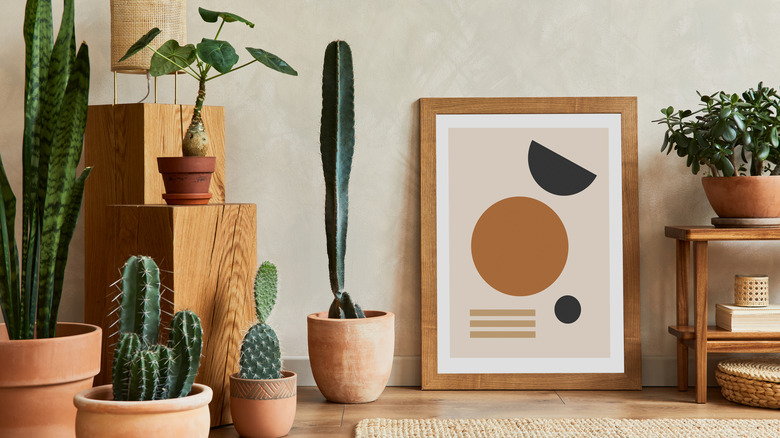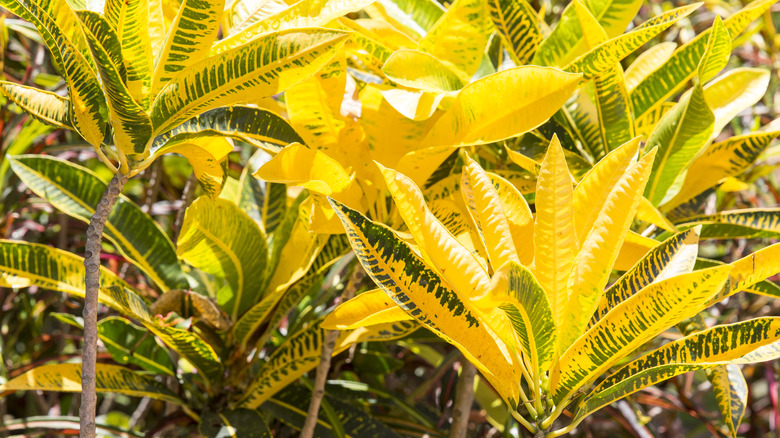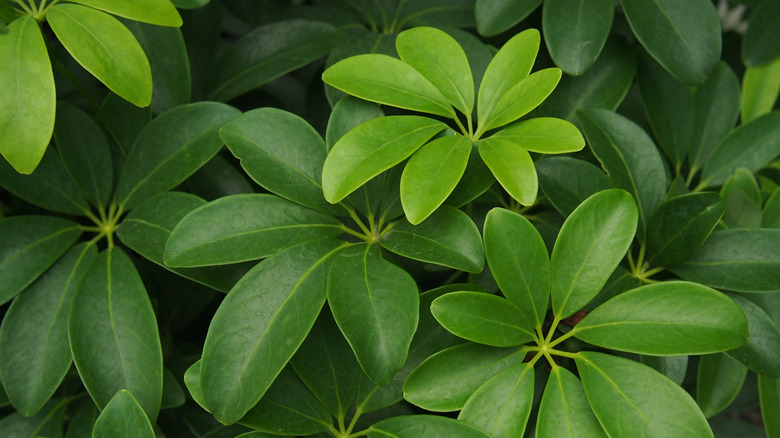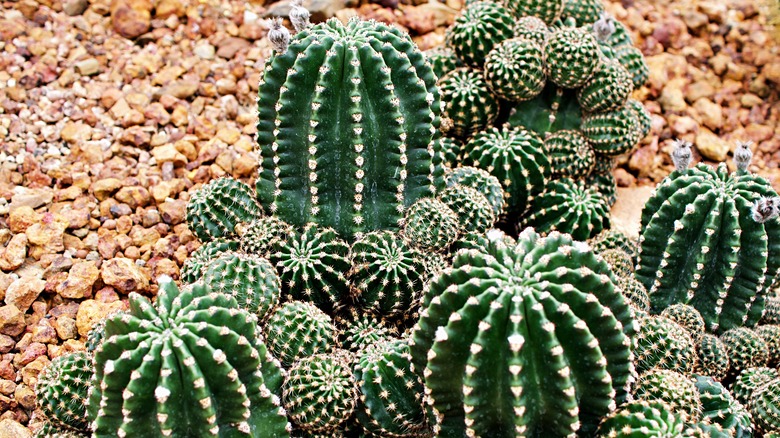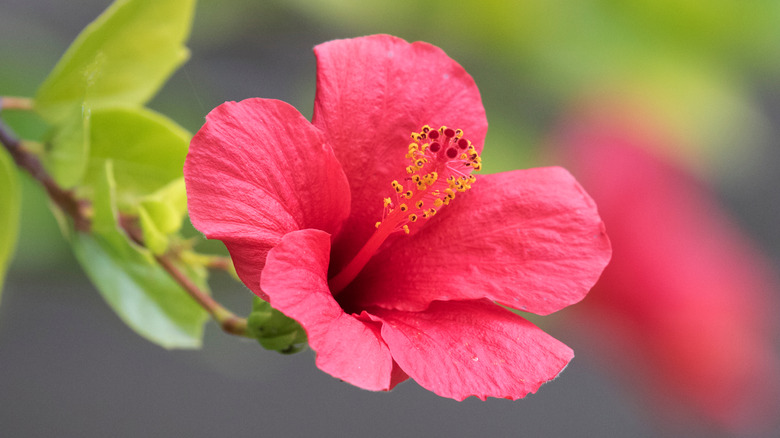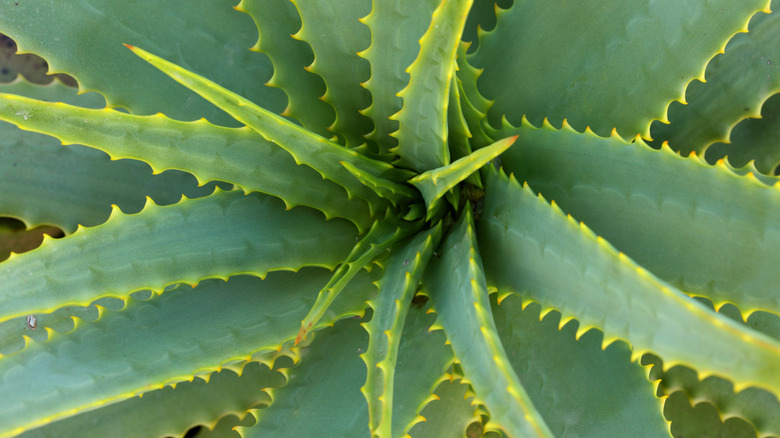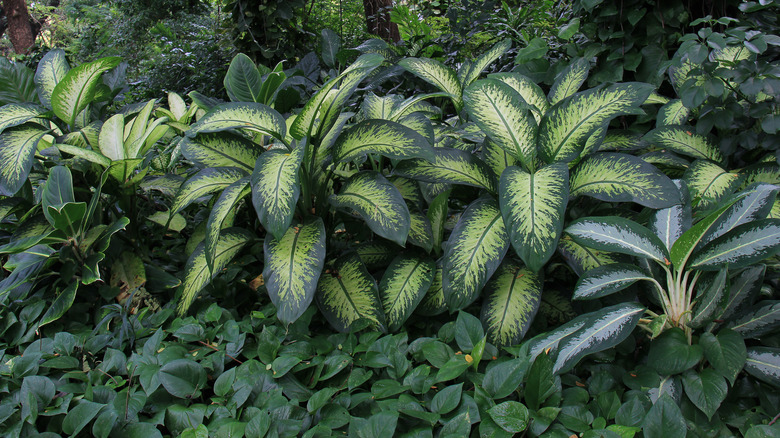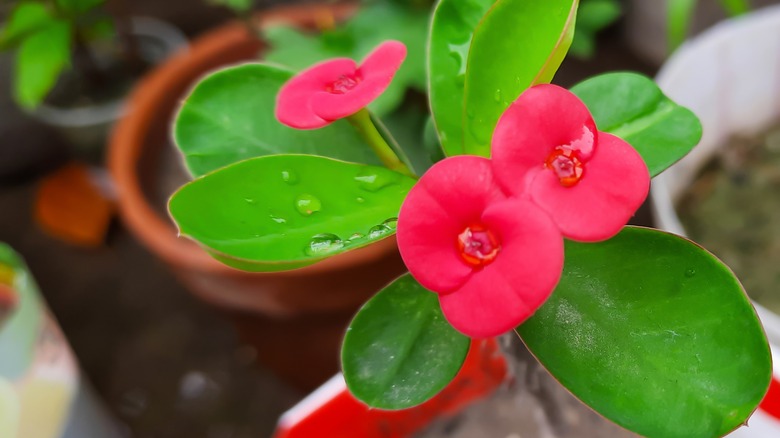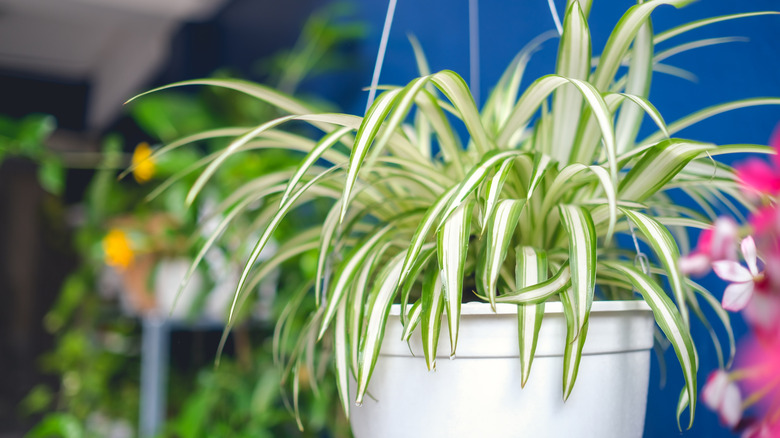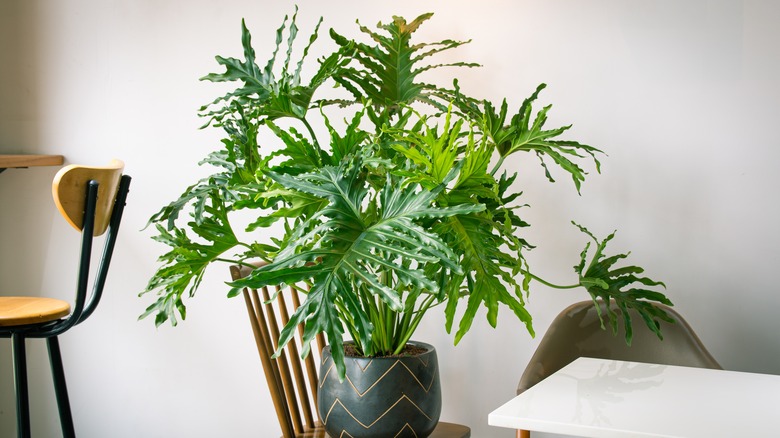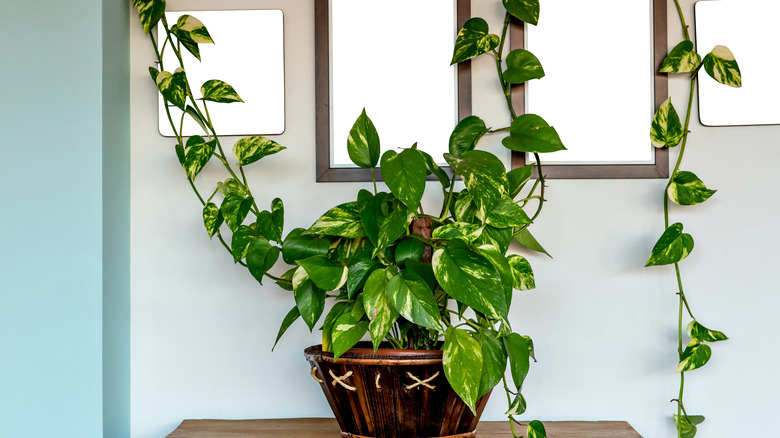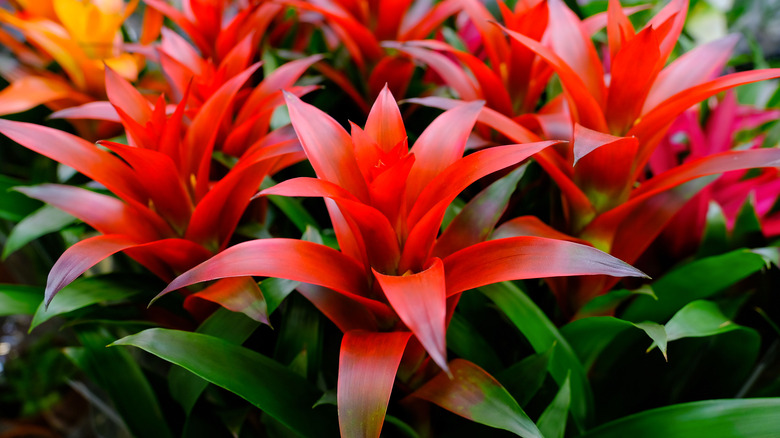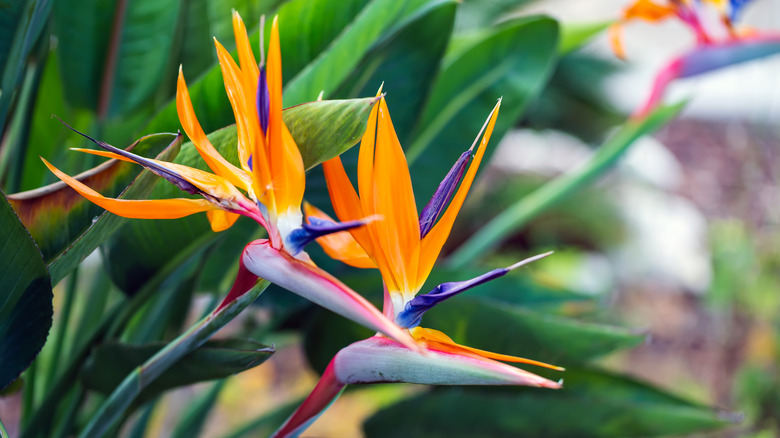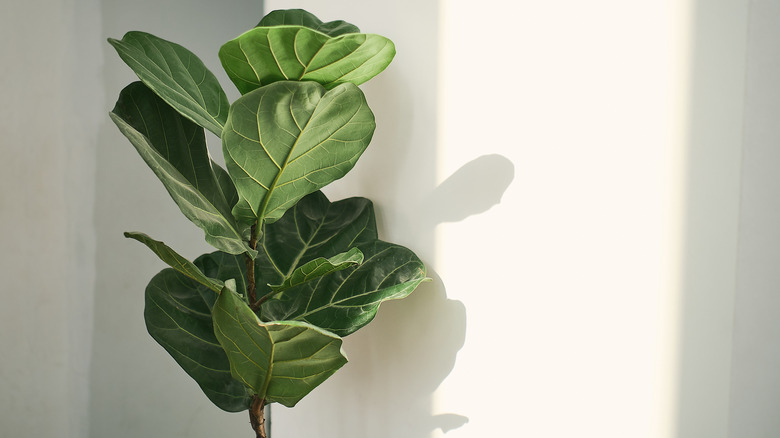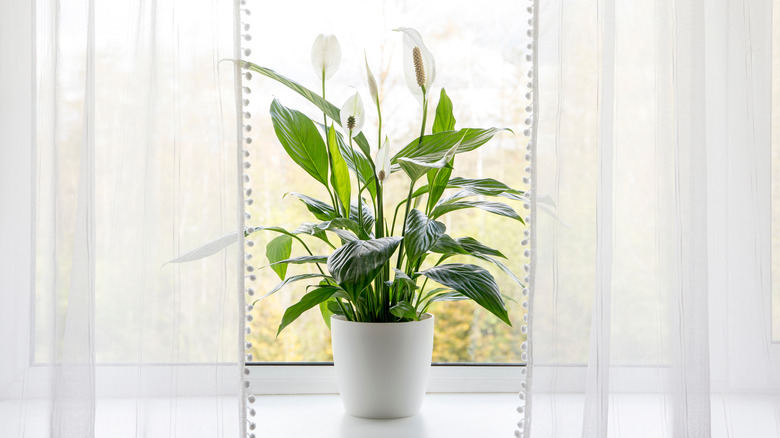The Best Houseplants To Have If You Live In A Warm Climate
According to American Meadows, most plants don't like it if it is above 90 degrees Fahrenheit outside for too long. In this heat wave, they will begin to droop and drop leaves. In addition, plants have immune systems that become weak in scorching weather because the plants will slow down photosynthesis to conserve energy.
However, there is still some good news. Plenty of plants thrive when it is warmer outside. With a little care, you can still have a flourishing garden in a hot climate. The first way to prevent your garden from being ruined come summertime is to choose plants that love hot weather. This tip is essential if you live in a climate that tends to be warm all year round, as many species love hazy, hot, and humid days. We have rounded up a few of our favorites for you to choose from, whether you are a beginner gardener or have an experienced green thumb. These are some of the easiest houseplants to grow if you live in a warm climate.
1. Croton (Codiaeum Variegatum)
Croton plants do well with lots of light and humidity, so they are a great fit if you live somewhere warm and a bit sticky. According to Gardeners' World, you might also hear these plants called Joseph's coat because of the color and shape of their leaves. They are very thick and pointy but come with streaks of many colors like pink, red, orange, and even yellow and green — just like Joseph's Biblical coat. In the warmer summer months, you might also see white or yellow flowers shaped like stars growing on them.
These plants love bright light and sunshine. They shouldn't ever be in an environment where the temperature is consistently less than 60 degrees Fahrenheit, as they prefer balmy weather. They do well in pots but need to be moved into a larger one about every two years, especially if they are root bound. This problem happens when the roots have nowhere else to go and start getting tangled up in each other.
2. Umbrella Tree (Schefflera Actinophylla)
Big, green, and leafy, an umbrella tree is ideal for warm places. According to the The Houseplant Resource Center, these trees get their names from the shape of their leaves. They grow in little clusters that look like umbrellas. You can find them in the wild in the hot climates of Southeast Asia and parts of Australia.
These plants are durable and easy to take care of, so if you are newer to having house plants, they are a good choice. It almost takes more effort to kill this plant than to keep it alive. When selecting a pot, make sure yours is big enough for the tree to have plenty of room to grow and breathe. In addition, it should have a drainage hole on the bottom to preven the soil from getting soggy in between waterings. Although they tend to do well in the heat, these plants prefer indirect sunlight, or their leaves will scorch, so be careful where you place it.
3. Cactus (Cactaceae)
A cactus is a cute and easy houseplant for anyone living in or near a desert. According to West Coast Gardens, cacti come in many different shapes, sizes, and variety, including the peacock cactus and zig zag cactus. It's easy to find something fun that easily fits into your garden. Since they are a desert plant, they require very little upkeep. However, your cactus can still get scorched if you give it too much sun. This problem is usually made worse in domestic situations because we place our plants on a windowsill, so the glass panes amplify the sun's rays.
Try placing your cacti collection on the south side of your home. This way, they can bask in the afternoon sun without getting too hot. When it comes to watering, you might think you hardly have to do it since these plants are from the desert. While cacti can survive a drought, that doesn't mean you should force them to do it. Be sure to water them at least once a week.
4. Tropical Hibiscus (Hibiscus Rosa Sinensis)
The tropical hibiscus is a beautiful flower that will make your home look like a tropical island. According to Gardenia, the flower's signature bright petals can grow up to six inches. Many gardeners like the texture of the flower's petals, which tend to be ruffled around the edges and overlap each other.
The best part about this plant is that because it is tropical, it loves the sun. In fact, it tends to do the best in full sun. However, being under shade for part of the afternoon won't hurt. During the summer, the tropical hibiscus tends to be very thirsty, so keep it nice and watered. If you live somewhere with lots of deer, they don't tend to snack on hibiscus. However, things like aphids and mealybugs tend to love having tropical hibiscus for lunch, so be sure to keep an eye out for them.
5. Aloe Vera (Aloe Barbadensis Miller)
Aloe vera is an ideal plant for warm climates. It's also great to have on hand for sunburns, too. Feel free to break open a stalk and use it to soothe your skin. However, remember that you should not ingest any gel from aloe vera grown at home, as it can really upset your stomach. According to Almanac, aloe vera can thrive with plenty of indirect sunlight. The plant will do better on a windowsill in a bright room than on your back porch without shade.
Aloe vera can be top heavy, so be sure to get a study pot to plant it in, like terra cotta. Terra cotta is also a good choice because it is porous. All the water will evaporate between waterings, so the plant doesn't sit in undrained liquid and start to get sick. To avoid this, choose a pot with a small hole at the bottom so the plant can properly drain.
6. Dumb Cane (Dieffenbachia Seguine)
These plants have a stunning leaf texture and hue. According to Greenery Unlimited, the plants are native to the rainforests of Mexico, most of South America, and the West Indies. It's called Dumb Cane because the sap can be toxic when ingested by pets or kids. Keep this plant out of reach from small members of your household.
Leaving the plant in direct sunlight can burn the leaves and cause the Dumb Cane to die. Try to infuse it with as much ambient light as you can instead. This plant can also do well under fluorescent light in a home office, but you will need to give it a little time to adjust to its new environment. It is known to have leaves that will tell you everything you need to know about the state of the plant. If it's too hot or thirsty, look at the leaves, and you will know what to do.
7. Crown of Thorns (Euphorbia Milii)
A crown of thorns is a bright, beautiful addition to any garden. According to MasterClass, the plant is sometimes called a Christ thorn or Christ plant. It comes from Madagascar, an island nation off the east coast of Africa. French government official Baron Pierre Bernard Milius introduced the plant to Europe in the early 1800s.
The succulent is known to be very hardy, easy to care for, and beautiful. However, it does have sharp, prickly thorns around its stalks and leaves (hence its name). So, you will need to handle it with care. In addition, if you ingest any part of the plant, you can become sick. If you have curious pets or small children in your house, keep them out of reach or skip this plant all together. Crown of thorn plants grow best through propagation rather than planting new seeds. If you want to start a new plant, see if you can obtain cuttings from a friend or local garden.
8. Spider Plant (Chlorophytum Comosum)
The spider plant is a large, fun plant for any warm climate. According to Gardening Know How, this plant is one of the most resilient, easiest plants to grow. The only real problem you might run into when caring for one is that sometimes the tips of leaves can turn light brown. This problem happens where too much fluoride is in the water and salt gets stuck in the soil. To prevent this, use filtered water to flush things out and prune back the leaves.
In general, spider plants need lots of bright light, but indirectly so they don't burn. Keep the soil nice and dry in between waterings to avoid root rot. If it's hot outside and you feel like cranking up the air conditioning, you won't have to worry about your spider plant shriveling up in the cold. While they love the warmth and sunlight, they can also do well between 55 and 65 degrees Fahrenheit.
9. Tree Philodendron (Philodendron Bipinnatifidum)
Serious plant parents should consider the Tree Philodendron. According to Gardener's Path, many people might not add this plant to their homes and gardens because it is unremarkable. However, the tree is native to the South American countries of Brazil, Argentina, Bolivia, and Paraguay, so it thrives in warmer weather and is a beautiful addition to any plant collection.
It goes by many other names, like lacy leaf, horsehead philodendron, or split leaf. Some might even call it a panda or fruit salad plant. The tree likes to grow strong and tall, leaving the stalk exposed towards the bottom as it sheds its lower leaves. If you keep the plant indoors, you can expect it to grow tall. Sometimes, the tree reaches heights of eight or even ten feet tall. Tree philodendron also like to grow outwards, but you can limit this growth through the size of the pot you choose. One of about 12 inches in diameter should keep things manageable for an indoor plant.
10. Devil's Ivy (Epipremnum aureum)
This plant is a devilish addition to any garden. According to My Garden Life, Devil's Ivy is a very hardy plant, making it an ideal choice for beginner gardeners or people who might think they have a brown thumb. Healthy plants have large, bright green leaves with yellowing variations throughout, making them very interesting visually.
Devil's Ivy can also spill out from its vase, so some people like to display it in a hanging planter. This way, it can cascade down over the sides of the pot and create trails of greenery. It does best in temperatures from about 60 to 80 degrees Fahrenheit, so if you have it outside on a hot day, make sure to go and move it into the shade, just in case. Water them every five to seven days and ensure the soil stays nice and moist. However, if the soil is too soggy, it can hurt the plant and stunt its growth.
11. Bromeliads (Bromeliaceae)
Bro, these plants are the best fit for warmer climates. According to Bromeliad Plant Care, there are nearly 3,000 different species of the plant, all of which are native to warm, tropical climates. They are no strangers to humid weather. These plants grow on the dark, moist forest floor in the wild. It won't take too much work to keep them happy if you live somewhere hazy and hot like Florida or Texas. However, if you live somewhere with dry heat, like Arizona or Nevada, you might need to mist your bromeliads more often to keep them in their prime.
When misting your bromeliads, remember to keep them just a little wet. When watering them for sustenance, remember that they are more suited to go long periods without being watered. If you water them too often, it can actually cause root rot and other problems. A final note: don't use metal watering cans, as bromeliads are sensitive to the chemicals and compounds in metals.
12. Bird of Paradise (Strelitzia Reginae)
What better option for your tropical garden than a Bird of Paradise, a beautiful, classic tropical plant. According to The Sill, the plant is native to South Africa but is a popular choice for many gardeners in the world. Typically, they are bright orange or blue in color, but sometimes you'll find a rare flower that is white.
The Bird of Paradise doesn't do as well inside a typical home, even though it loves the heat. A garden shed, a green house, or even a covered patio are the best places for your plant to thrive. When caring for the plant, keep in mind that a pest known as spider mites can love it just as much as you do. If it starts to wilt or the leaves begin to turn yellow, you will need to get rid of pests with a natural pesticide spray.
13. Ficus (Ficus Benjamina)
If you are a beginner gardener and live somewhere warm, consider bringing a Ficus home to start your plant collection. According to New Garden Landscaping & Nursery, the plant is an easy, low maintenance option for beginners. However, if you cut or damage the leaves of your Ficus, the sap can irritate your skin, so be mindful. Keep pets and kids from ingesting its leaves, as they can cause stomach irritation. It likely won't cause a trip to the emergency room, but your pet or child could experience vomiting and diarrhea.
When watering your Ficus plant, keep it a bit drier than most other houseplants. Don't ever skip watering to the point that it starts to wilt. However, you don't need keep to a regular schedule like other plants. When winter comes, don't panic. Ficus grow well in temperatures anywhere from 55 to 85 degrees Fahrenheit, so it will be fine if your home gets a bit colder for a few months.
14. Peace Lily (Spathiphyllum)
Peace lilies are a beautiful plant to have on hand if you live in a warm climate. According to the Almanac, they can be temperamental, so they might not be the best for beginners. However, once you master their care, they are a great addition to any home. If you keep your lilies inside, you can expect them to be about 16 inches tall. However, if you plant them in your outdoor garden, they usually end up being about six feet tall — a substantial difference.
Something important to remember about growing an indoor peace lily plant is that they contain a compound known as calcium oxalate. When ingested, this can be toxic and sometimes even fatal to pets. Keep these plants off the ground where your furry friends can't reach them. If you have a cat that can climb, it's probably best to skip this option to keep them safe and sound.
